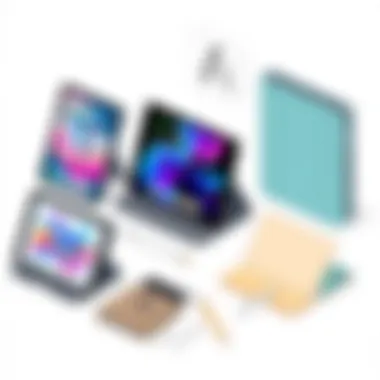Exploring the iPad: Its Evolution and Impact


Product Overview
The iPad stands as a testament to how consumer technology has evolved. Launched by Apple in 2010, it did not just introduce a new product; it effectively reshaped how many perceive personal computing. With each iteration—whether it be the iPad Air, iPad Pro, or the standard models—Apple has consistently refined its features to cater to both tech aficionados and everyday users.
Key Features and Specifications
Exploring essential features reveals what truly sets the iPad apart:
- Retina Display: The stunning screen quality is hard to overlook. The vivid colors and crisp graphics make it ideal for everything from video streaming to creating graphical content.
- Apple Pencil Compatibility: For those who enjoy drawing or note-taking, the seamless integration with the Apple Pencil enhances user creativity.
- Powerful Chips: Models feature Apple's latest chip technology, such as the A14 Bionic or M1 chip, delivering performance that rivals some MacBooks.
- Battery Life: Users can often enjoy up to 10 hours of usage on a single charge, making it convenient for daily tasks.
- iPadOS: The refined operating system brings desktop-class features to the iPad, making multitasking and app management smoother than ever.
These highlights only scratch the surface, as the device continuously adapts to consumer needs.
Performance and User Experience
When it comes to performance, the iPad excels both in theory and practice.
Hands-on Testing and Evaluation
Real-world testing demonstrates that switching between applications is virtually instantaneous. Whether one is editing photos using Adobe Lightroom or engaging in a video call via Zoom, the absence of lag adds to a positive user experience. Many reviewers highlight that heavy-duty tasks, like gaming or high-definition video editing, remain smooth without a hitch.
User Interface and Ease of Use
Navigating iPadOS feels intuitive, thanks to well-designed gestures and an organized layout. Users familiar with iOS will find transitioning to the tablet an easy feat. Furthermore, accessibility features cater to various needs, making the device suitable for a wide range of individuals.
Comparison with Similar Products in the Market
When stacked against competitors like the Samsung Galaxy Tab series or Microsoft’s Surface Pro, the iPad often stands out due to its cohesive ecosystem and robust app offerings. Although some rival products may offer unique features, the seamless integration with Apple services like iCloud and iMessage generally sways user preference toward the iPad.
Design and Build Quality
Apple is known for its attention to detail, and the iPad showcases this ethos beautifully.
Detailed Analysis of Design Elements
The sleek aluminum body is not just visually appealing but also contributes to its durability. The thin profile makes it lightweight and portable, an attractive feature for those who are always on the go.
Materials Used and Durability
Crafted from high-quality materials, the device is built to withstand the rigors of daily life while maintaining its aesthetic appeal. Unlike many plastic alternatives, the iPad’s construction hints at longevity.
Ergonomics and Aesthetics
Holding the iPad for extended periods proves comfortable, thanks to its balanced weight distribution. Its design offers a minimalist elegance, which is a significant draw for style-conscious consumers.
Technology and Innovation
Apple’s ability to innovate keeps the iPad at the forefront of consumer technology.
Exploration of Groundbreaking Technology
Features like Face ID, an advanced facial recognition system, offer security and user convenience. Additionally, the iPad Pro’s Magic Keyboard elevates productivity, bridging the gap between tablet and laptop functionalities.
Potential Impact on the Consumer Tech Industry
The iPad has influenced how tablets are perceived—not merely as secondary devices but as primary computing tools. This shift has prompted competitors to rethink their strategies and offerings.
Future Trends and Developments
As technology evolves, we can expect future iPad iterations to delve deeper into AR (Augmented Reality) and AI (Artificial Intelligence), enhancing user engagement and interactivity.
Pricing and Value Proposition
Understanding the pricing landscape aids consumers in making informed decisions.
Pricing Details and Affordability
Pricing can vary significantly based on the model. The entry-level iPad starts at a price point accessible to most, while the iPad Pro commands a premium, reflecting its high-end features.
Comparison of Value with Competitors
When comparing the iPad’s value against offerings from Samsung or Microsoft, it’s crucial to weigh the benefits of the Apple ecosystem: reliability, app selection, and support. Consumers often find that the iPad’s longevity justifies the initial expense.
Recommendations and Final Verdict
For anyone deliberating on which tablet to buy, the iPad’s rich functionality and stylish design hold strong appeal. It caters to varying user needs, from casual browsing to professional-grade tasks. In short, its balanced design and performance make it a worthy investment.
The Evolution of the iPad
In a rapidly evolving tech landscape, the iPad stands as a compelling example of innovation and adaptability. Since its introduction, it has reshaped how we interact with technology, serving as a bridge between traditional computing and mobile devices. Understanding the evolution of the iPad is crucial for appreciating its role not just as a device, but as a cultural and technological phenomenon.
The story begins in 2010, when Apple’s late co-founder Steve Jobs revealed the first iPad. This product was not merely an oversized iPhone; it represented a unique category of device that had implications for how people consume media, communicate, and perform work tasks. With a portable design and an intuitive interface, the iPad enables users to engage with digital content in a way that was previously unattainable.
This section will explore key aspects of its evolution, highlighting the challenges faced, the innovative solutions developed, and the impact these have had on users across various sectors. By examining the iPad's journey, tech enthusiasts can glean insights into the broader trends in technology—such as design thinking, user-centric innovation, and the increasing blurring of lines between personal and professional tech.
From Concept to Release
From its nascent stages to its official launch, the iPad's development was marked by significant hurdles and breakthroughs. Apple was keenly aware that entering a new market required more than just a novel gadget. They needed to create an experience that would resonate with consumers. The concept was conceived through a series of brainstorming sessions and prototypes; not everything was clear from the outset. Initial ideas revolved around a better way to surf the internet on-the-go, but it expanded into a multi-functional device.


During this timeframe, Apple faced skepticism from critics who anticipated its failure. Questions arose about whether a device positioned between a smartphone and a laptop could gain traction. Yet, Apple meticulously refined the device to ensure it met a market demand not yet fully articulated. Features like touch interaction, a battery that could last hours, and multimedia capabilities formed the cornerstone of its development.
On January 27, 2010, amidst considerable anticipation, the iPad was unveiled to the world. The reaction was mixed, yet forward-thinking individuals saw its potential as a game changer. The device's successful launch set the stage for its future iterations and targeted expansions into areas such as education, business, and content creation.
Major Milestones in iPad Development
The iPad's evolution has been dotted with parental milestones that helped carve its place in the tech sector. Each iteration brought enhancements that addressed consumer feedback and emerging technology trends. Here are some of the most significant developments:
- 2011: Introduction of the iPad 2 - Thinner, lighter, and more powerful, this version introduced front and rear-facing cameras, paving the way for applications like Skype and Facetime, enhancing communication with a personal touch.
- 2012: Retinal Display and LTE Connectivity - The third generation showcased Retina display technology, improving visual clarity to a discernible effect. With the introduction of LTE, internet speed saw a remarkable boost, making streaming and downloads far more efficient.
- 2014: The iPad Air and iPad Mini - Design and weight were crucial themes with the release of the iPad Air. This shift towards portability made it even more appealing to users on the move. The iPad Mini appealed to those preferring size without sacrificing function.
- 2015: The iPad Pro Era - Apple’s foray into the professional sphere introduced a larger screen and support for accessories like the Apple Pencil and Smart Keyboard, elevating the device from consumption to creation. For graphics designers and business professionals alike, this was a significant step in versatility.
Throughout these advancements, Apple remained focused on maintaining a balance between user friendliness and technical prowess. This effort not only improved customer satisfaction but also broadened the audience, encompassing students, professionals, and hobbyists alike.
In summary, the evolution of the iPad presents a compelling narrative of innovation, strategically aligning technological advancements with consumer needs. With each model introduced, Apple not only solidified its market presence but also changed how society, at large, engages with technology.
Distinct iPad Models
The concept of distinct iPad models is crucial in understanding how this versatile tablet can cater to a wide variety of users. Each model is designed to meet different needs, showcasing Apple’s commitment to appealing to both casual consumers and professionals who demand high performance. By breaking down the specific features and advantages of each version, we can make a better choice depending on personal or professional needs.
iPad Standard
Starting with the iPad Standard, this model serves as the gateway into the iPad ecosystem. It is designed for users who need a reliable device for general tasks such as browsing the web, streaming videos, or reading e-books. Notably, the iPad Standard combines a balanced performance with affordability, making it popular among families and educational institutions.
- Key Features: The 10.2-inch Retina display provides vibrant color and clarity. Its compatibility with the first-generation Apple Pencil enhances its versatility.
- Benefits: Users who aren't heavy-duty tech enthusiasts can benefit from its simplicity and ease of use.
The iPad Standard manages to deliver a solid value without overwhelming users with unnecessary features.
iPad Mini
On the flip side, the iPad Mini caters to those who prefer a more compact option without sacrificing functionality. This model stands out thanks to its lightweight design, making it perfect for on-the-go situations.
- Key Features: Sporting an 8.3-inch Liquid Retina display, the iPad Mini packs a punch with an A15 Bionic chip, offering fine speed and responsiveness.
- Considerations: Its size might be a double-edged sword; while it's portable, users could find the smaller screen challenging for intensive tasks.
All in all, the iPad Mini appeals to travelers and readers wishing to have a robust yet compact device at their fingertips.
iPad Air
Next up is the iPad Air, which bridges the gap between performance and portability. This model is often a go-to for creative professionals seeking a robust tablet that doesn't skimp on capabilities.
- Key Features: The 10.9-inch Liquid Retina display is not only stunning but also supports the second-generation Apple Pencil. The M1 chip provides unrivaled speed and efficiency.
- Benefits: Ideal for graphic designers and digital artists, the iPad Air enables seamless multitasking and app switching.
With a focus on performance and an expansive screen, the iPad Air is a solid choice for those who favor productivity on the move.
iPad Pro
Finally, we have the iPad Pro, essentially the powerhouse of the iPad lineup. Tailored for professionals who require high performance, this model brings advanced technology right into the hands of users.
- Key Features: It boasts an 11-inch or 12.9-inch Liquid Retina XDR display, dazzling with extreme brightness and vivid colors. With the M2 chip, it handles heavy tasks with ease.
- Industry-Specific Applications: Whether it’s video editing, 3D modeling, or graphic design, the iPad Pro supports a plethora of professional applications.
For creatives and business users, the iPad Pro is a game changer, merging the best of technology, art, and utility into one seamless experience.
"The distinct models of the iPad are crafted to cater to audiences in various spaces. From the everyday user to the artist, there's something for everyone."
Software Ecosystem and Functionality
The world of the iPad is intricately woven into its software ecosystem, which plays a vital role in defining its functionality and user experience. Without this ecosystem, the iPad would merely be a device with hardware, lacking value and utility. Software not only enhances the functionality of the device but also shapes user behavior and interaction patterns. In today’s fast-paced digital landscape, understanding the interplay between hardware and software is crucial for tech-savvy individuals, who not only seek devices that serve immediate needs but also grow with them over time.
iPadOS: Features and Innovations
The launch of iPadOS marked a significant milestone in the iPad's journey. This operating system, built specifically for the iPad, brings features that set it apart from its iPhone counterpart. iPadOS offers a more desktop-like experience, enabling users to multitask with ease. The ability to utilize split view and slide over means that one can juggle different apps simultaneously, significantly improving productivity.
Furthermore, the introduction of widgets has transformed the home screen into a personalized dashboard of critical information. Widgets provide quick access to relevant apps, calendars, and other necessities, without diving deep into multiple applications. Users can find themselves scrolling through content more efficiently, saving time in their busy lives.
One cannot overlook the system’s enhanced support for the Apple Pencil. With iPadOS, handwriting recognition just got a lot sharper, making it a breeze to convert handwritten notes into text or doodle while in meetings. These innovations aim not only to expand what users can do on the iPad but also to create a more enjoyable interaction.
Apps and Productivity Tools
The true magic of the iPad often lies in its vast array of applications tailored for diverse needs. The App Store is brimming with innovative software that caters to every facet of life, from consumption to creation. Productivity tools like Microsoft Office and Google Workspace enhance document editing and collaboration. For artists, apps like Procreate transform the iPad into a canvas that sparks creativity.
A notable mention in this context is Notability, an app that combines comprehensive note-taking capabilities with audio recording features. This is particularly useful for students and professionals who wish to synthesize lectures or meetings with detailed notes.
Moreover, with the growing trend towards remote work, apps that facilitate project management and communication—such as Slack and Trello—have become indispensable. They not only keep teams organized but also foster collaboration across distances, reaffirming the relevance of the iPad as an essential tool for contemporary workflows.
Gaming on the iPad
Let's not forget the phenomenal gaming experience that the iPad engenders. Gone are the days when mobile gaming was synonymous with a casual pastime. Nowadays, the iPad supports high-quality games that rival traditional consoles. Titles such as Call of Duty: Mobile and Genshin Impact showcase not just exceptional graphics but also intricate gameplay made possible by powerful processors.
With the integration of multiplayer features and the large screen real estate of iPads, playing with friends or diving into immersive environments has never been easier. The introduction of Apple Arcade offers a subscription model that opens the door to a library of exclusive games. This gives gamers a broader access to unique content without feeling the pinch of paying for each title separately. As a result, the iPad positions itself as a vital part of the gaming industry, appealing to serious gamers and casual players alike.
In summary, the software ecosystem surrounding the iPad significantly enhances its functionality. With the arrival of iPadOS, a plethora of productivity apps, and its ability to deliver a top-tier gaming experience, the iPad continues to establish itself not just as a gadget, but as an indispensable tool that adapts to its user’s lifestyle.
Hardware and Performance
When discussing the iPad, one can hardly overlook the crucial role that hardware and performance play in the user experience. The iPad isn’t merely a shiny blanket of glass and aluminum; it’s a fine-tuned machine designed for speed, efficiency, and versatility. In this section, we will delve into the key components that elevate the iPad beyond being just a tablet, exploring display technology, processing power, and battery life—each a cornerstone of the overall functionality.
Display Technology
The display of the iPad is often the first aspect that captures an individual's attention. It is not just about being visually appealing; it is about clarity, responsiveness, and accuracy. Apple’s Liquid Retina displays, found in the iPad Pro, for instance, offer a resolution that is hard to match. With an emphasis on color accuracy and brightness, these screens are made for creators and consumers alike.


Consider the ProMotion technology that supports refresh rates up to 120Hz. This isn’t just marketing fluff—it enhances everything from scrolling to gameplay, providing a smoother interaction that keeps users engaged.
- Impact on Usage: Whether one is illustrating in Procreate or watching a movie on Netflix, the display technologies enrich experiences by making every pixel count.
- Considerations: However, it’s worth noting that high-resolution displays can demand more from the battery. Users should always keep in mind the balance between battery life and visual performance.
Processing Power: A Series Chips
Beneath the sleek exterior, the real magic happens with the processing power found in the A series chips. Apple's custom silicon sends the iPad's performance soaring beyond mere numbers on a spec sheet. The A14 Bionic chip, for example, showcases a hefty improvement in speed and efficiency compared to its predecessors.
- Why It Matters: For those engaged in graphic design, video editing, or intense gaming sessions, the power of these chips minimizes lag and enhances multitasking capabilities. It’s common to see apps that were previously limited to desktop computers now running seamlessly on iPads.
- Trend Insights: As Apple continues to release even more advanced chips, like the M1 chip now seen in the iPad Pro, the landscape of what’s possible on a mobile device is changing dramatically.
Battery Life and Charging Solutions
No one wants a device that runs out of juice mid-project or during leisure time. Apple has consistently put a premium on battery life, and the iPad manages to support long hours of usage. With life spanning anywhere from 10 to 18 hours depending on usage and model, users can expect reliability.
Charging solutions have also evolved. The introduction of USB-C in the iPad Pro allows for faster charging and flexible connectivity with various accessories. Additionally, the Apple ecosystem enhances this experience, allowing for seamless integration with devices like the iPhone or MacBook, which can charge the iPad when needed.
- Practical Takeaways:
- Users can optimize battery life through smart settings in iPadOS.
- Understanding the nuances of battery performance across different tasks can help in planning usage effectively.
"The strength of the iPad lies not just in what it can do but in how well it does it."
For those wanting detailed specifications and performance benchmarks, resources such as Wikipedia and Apple's official site can offer more insights.
Accessories and Enhancements
When it comes to maximizing the capability of an iPad, accessories play a pivotal role. This section highlights the various enhancements available for the device, which not only augment the usability but also tailor the iPad experience to specific needs and preferences. Whether one is a creative professional, a student, or a casual user, the right accessories can transform how the iPad is utilized in daily life.
Keyboards and Cases
The introduction of keyboards has been a game changer for many iPad users, making typing effortless and efficient. Brands like Apple provide their own keyboard case options, such as the Magic Keyboard. This accessory combines a full-sized keyboard with a sleek design, allowing users to comfortably type emails, documents, or even codes. A solid keyboard enhances productivity, especially for those who use the iPad for work or academic purposes.
Cases, on the other hand, serve not only as protection against drops and scratches but also as a means of personal expression. There are numerous options available, from rugged cases designed for outdoor use to stylish folio cases that can fit seamlessly into a professional setup. The right case can elevate the aesthetic appeal of the iPad, while also reflecting the user's personality.
Apple Pencil and its Applications
The Apple Pencil is perhaps one of the most significant accessories available for the iPad. It transforms the device into a powerful tool for creative professionals and hobbyists alike. Whether sketching, annotating documents, or navigating apps, the precision of the Apple Pencil is hard to beat. Many art apps, such as Procreate and Adobe Fresco, are optimized for the Pencil, providing users with an expansive canvas to explore their creativity.
Moreover, the Pencil enhances educational experiences as well. Students can take handwritten notes directly in apps like Notability or GoodNotes, which can later be easily organized and accessed. This feature bridges the gap between traditional pen and paper and digital convenience, making learning more interactive.
Third-Party Accessories
While Apple offers a solid lineup of accessories, third-party options shouldn't be overlooked. Companies like Logitech and Brydge cater to a variety of needs, producing keyboards and protective cases that often come at a lower cost without skimping on quality. These products can provide a unique blend of features that might suit specific workflows better than their Apple counterparts.
Additionally, other accessories like external storage options, additional charging stations, or even gaming controllers can greatly enhance the versatility of the iPad. Depending on the tasks at hand, a suitable accessory can unlock new capabilities that extend the device’s functionality beyond its base offerings.
In summary, considering the array of accessories and enhancements available for the iPad is essential for anyone keen on maximizing their usage. They are not just add-ons; they are integral parts of the iPad ecosystem, allowing for customization based on individual preferences and needs.
User Experience and Interface
In today’s tech landscape, the user experience (UX) and interface of devices play a pivotal role in engaging users and keeping them invested in their technology. When it comes to the iPad, these elements are not just supplementary; they are foundational to how users interact with the device on a daily basis. The ultimate goal here is to make technology intuitive, efficient, and enjoyable to use. Apple's iPad has often been recognized for its user-friendly experience, but what does that really entail?
It begins with the design choices. Apple has consistently prioritized simplicity in its UX. The layout is clean, the icons are recognizable, and navigating the device is straightforward. This simplicity belies a deeper complexity—under the hood, the iPad operates with power that meets diverse user demands, from casual browsing to intensive graphic design tasks. Elements such as gesture control, touch responsiveness, and fluid animations combine to create an experience that feels as smooth as butter.
The benefits of this intuitive design are manifold. First, it facilitates a shorter learning curve for new users. Whether you’re a seasoned expert or a first-time tablet user, you can pick up an iPad and feel reasonably comfortable after only a few minutes. This broad accessibility widens the appeal of the device, catering to tech-savvy individuals, kids, and older adults alike.
Moreover, the UX is not just about ease of use; it’s also about engagement. A well-crafted interface can captivate a user’s attention and keep them coming back for more. Whether watching a video on YouTube or sketching a masterpiece in Procreate, the iPad enhances the activity, making the user feel more connected to their task.
Intuitive Design Considerations
The principle of intuitive design involves more than just making things look good; it’s about anticipating user needs and behaviors. Apple��’s design philosophy embodies this by focusing on how people interact with devices in their daily lives. The placement of buttons, the gestures required to perform certain tasks, and the way information is presented all influence how seamlessly a user can navigate the iPad.
Important considerations include:
- Accessibility of Features: Users should easily find the tools and settings they need. Frequently used apps are prominently displayed for quick access, while less common features can be tucked away without cluttering the main interface.
- Feedback Mechanisms: Every action needs a response. Whether it’s a subtle sound, a visual effect, or vibrational feedback, these cues inform the user that their input has been recognized. This significantly enhances the overall experience.
- Cohesiveness: All design elements need to work together harmoniously. For instance, visuals, typography, and interactive elements complement each other. This consistency creates a holistic experience, making the iPad feel like an integrated tool rather than a collection of disparate parts.
In practice, these design considerations translate to a smoother workflow, whether users are composing a document, playing games, or running complex applications. The design choices converge to craft an experience where the technology almost feels like an extension of the user’s own abilities.
Accessibility Features
In an age where inclusivity is paramount, the iPad takes significant strides to accommodate its users by integrating a range of accessibility features designed to empower everyone. Apple has made a point to ensure that their devices can be used by individuals with various disabilities, creating solutions that are not only practical but also innovative.
Some noteworthy features include:
- VoiceOver: This screen reader enables visually impaired users to enjoy the iPad’s functions by providing audible descriptions of on-screen elements.
- Magnifier: The iPad can act as a digital magnifying glass, utilizing the camera to help users read small texts and see details more clearly.
- Switch Control: For users with limited mobility, this feature allows them to control the iPad through external switches, making interactions more accessible.
- Text Size Adjustments: Users can easily adjust text size and apply bold text to enhance readability, ensuring that information is easily accessible.
"The beauty of technology lies in its ability to enhance the human experience, and the iPad accomplishes this by considering various user needs and preferences."
The thoughtful implementation of these features underscores Apple’s commitment to inclusivity. It’s not just about having the latest style; it’s also about ensuring that every user can enjoy the iPad to its fullest potential. This conscious effort contributes to the iPad’s reputation as a versatile device capable of enhancing lives in meaningful ways.
When the user experience aligns with inclusive design, it results in a powerful tool that appeals beyond demographics. In a world increasingly reliant on digital interfaces, the success of the iPad exemplifies how thoughtful UX and accessibility can converge to create innovative technology.
iPad in Education
In recent years, the role of technology in education has rapidly evolved, placing the iPad at the forefront of this transformation. The device's versatility and functionality have made it an indispensable tool in educational settings. Whether it's for streamlined communication between teachers and students or as a resource for interactive learning, the iPad serves not just as a gadget, but as a gateway to new forms of knowledge acquisition. Embracing the iPad in education brings forth numerous benefits that fundamentally alter how students engage with their learning environments.
Digital Learning Tools


Digital learning tools on the iPad offer students access to a wide array of resources and applications that cater to various learning styles. For instance, apps like Duolingo for language learning or Notability for note-taking have become essential components in a student’s toolkit.
The ability to access online libraries, interactive textbooks, and educational videos enhances the learning experience significantly. Here’s how the integration of these tools manifests:
- Engagement: With visually appealing content, students are more likely to remain captivated by the subject matter. Traditional textbooks don’t quite spark the same excitement as a dynamic app.
- Personalization: Students can learn at their own pace, revisiting challenging material as needed. This individualized approach helps cater to different levels of comprehension.
- Collaboration: Tools such as Google Classroom allow students to collaborate on projects and assignments in real-time, regardless of location.
In this vein, the potential for enhanced engagement and active participation in the learning process cannot be overlooked. The flexibility afforded by the iPad ultimately enriches the educational experience.
Classroom Integration
Integrating iPads in the classroom presents unique opportunities and challenges. Teachers can utilize the device to streamline lesson plans, conduct assessments, and track student progress. However, it’s not just about placing an iPad in every student’s hands; it's about how effectively these devices are integrated into the existing curriculum.
Considerations for successful integration include:
- Professional Development: Training educators on how to maximize the use of iPads is crucial. It’s essential that they are comfortable navigating apps and know where to find resources to support their teaching.
- Curriculum Alignment: The applications and tools chosen should align with learning outcomes. Having a multitude of digital resources is only beneficial if they effectively align with curriculum goals.
- Tech Support: Setting up a reliable support system can significantly alleviate frustrations that may arise from tech-related issues during class. Technical difficulties can derail the flow of a lesson, making it imperative to have quick solutions in place.
Reviewing the iPad’s performance within educational frameworks reveals the impact it can make on enhancing traditional teaching and learning methods. By weaving technology into the fabric of the classroom, educators can foster an environment where both teachers and students are agile in their approach to learning.
"Modern education cannot be achieved without embracing technology. The iPad is a prime example of how education can evolve over time."
As we proceed to analyze its application in education, one cannot ignore the profound implications the iPad holds for fostering skill acquisition and digital literacy for future generations.
iPad in Business
When considering the iPad in the realm of business, it’s hard to overlook the profound impact this device has made in workplace dynamics. As companies continue to embrace remote work and flexible solutions, the iPad has positioned itself as a reliable tool for productivity and creativity. The importance of this topic lies in its potential to enhance operational efficiency, streamline communications, and support a wide range of business functions, all while providing the mobility modern professionals require.
The iPad caters to tech-savvy individuals seeking to harness the power of advanced yet user-friendly technology. Unlike traditional laptops, it delivers portability without sacrificing performance. Its design and functionality appeal to both seasoned executives and fresh entrepreneurs. This section dives into the specifics of how the iPad influences daily operations within various businesses.
Remote Work Capabilities
As remote work becomes increasingly commonplace, the iPad stands out as an ideal companion for professionals navigating their tasks from home or in transit. One of the notable features of the iPad is its seamless connectivity. Whether through Wi-Fi or cellular networks, users can easily access needed files, video conferences, and collaborative platforms without hassle. This flexibility encourages robust communication, enabling teams to stay engaged irrespective of location.
Moreover, the iCloud integration across devices ensures that your files are not just stored but easily shared. Those working on a group project can comment or edit documents in real-time, providing a fluid workflow. Key attributes contributing to remote work capabilities include:
- User-Friendly Interface: No learning curve means getting right into productivity.
- Versatility in Applications: Software options from Microsoft Office to Zoom meet various business needs.
- Long Battery Life: Extended usage without constant recharging enhances work reliability.
For instance, suppose you’re in a marketing role and need to present a strategy. You can prepare your slides on your iPad during your morning commute and deliver them directly to your team during a video call, all while juggling multiple projects easily.
Industry-Specific Applications
The versatility of the iPad is not just generic; it extends deeply into industry-specific applications designed to meet unique demands across fields. Different sectors can utilize the iPad to customize their approach to tasks, enhancing productivity.
In healthcare, for example, doctors and nurses use specialized medical apps to access patient information and medical records swiftly, facilitating better patient care. Similarly, in construction, contractors can redesign plans using architectural software directly on-site, ensuring real-time updates and enhancing communication with clients and teams.
Here’s a glimpse of how various industries leverage the iPad:
- Retail: iPads serve as point-of-sale systems, enabling smooth transactions and inventory management.
- Education: Teachers and students utilize educational tools to enhance learning experiences, with apps that cater to different learning styles.
- Real Estate: Agents can showcase properties with virtual tours, using the high-definition display to captivate potential buyers.
The ability to tailor applications to fit specific needs not only optimizes workflows but also enhances the overall user experience. The iPad's applications create a rich tapestry of opportunities across diverse sectors, proving that it is an integral part of contemporary business strategies.
In summation, the iPad is not just a device; it’s a multifaceted tool that fosters efficiency and innovation in the business landscape. Its remote work capabilities and industry-specific applications showcase why it continues to be a game-changer in how we do business today.
Comparative Analysis with Competitors
In a landscape crowded with various tablets, understanding the iPad's positioning against its competitors is not just a casual exercise—it’s crucial for consumers and tech enthusiasts alike. The iPad, known for its sleek design and robust functionality, must continuously hold its ground against the likes of Android tablets and Windows devices. This analysis reveals the key differentiators that can influence a buying decision, the strengths of each platform, and considerations that guide users in choosing the right device for their needs.
Android Tablets
Android tablets are often touted for their versatility and affordability. Many brands, such as Samsung with their Galaxy Tab series and Lenovo with its M10 model, offer a wide range of choices tailored to different budgets. This open-source operating system allows manufacturers to customize the user experience extensively. Users familiar with Android phones might find a seamless transition to these tablets, leveraging the same apps and ecosystems they’ve grown accustomed to in their smartphones.
Among the standout features of Android tablets is the abundance of choices. Consumers can select devices with varying screen sizes, processing speeds, and price points. More importantly, Android allows the installation of third-party apps that might not be available on the App Store, granting users a degree of freedom.
However, this diversity comes with a caveat. The user experience might not be as consistent across devices as it is with an iPad. Performance can vary significantly based on the manufacturer and the hardware. As a result, software updates and security patches might lag, leaving some devices vulnerable.
"In the race of tablets, choice is both a friend and a foe—Android’s flexibility can be a double-edged sword."
Windows Devices
When it comes to Windows tablets, devices like the Microsoft Surface series pose a formidable challenge. The synergy between hardware and Windows 10/11 enables users to run full desktop applications on a portable device. For business professionals who rely on programs like Microsoft Office, this represents a significant advantage over the iPad, which primarily focuses on its app ecosystem.
Windows tablets often cater to users who need the functionality of a traditional computer in tablet form. The seamless integration with the Windows operating system allows multitasking with ease, making it suitable for both work and play. Moreover, features like desktop mode can transform a Windows tablet into a compact workstation, ideal for presentations or heavy lifting when needed.
Nonetheless, this does not come without drawbacks. Windows tablets can be bulkier than their iPad counterparts, potentially sacrificing portability for functionality. Battery life, often a critical factor, tends to vary, and many users report shorter usage times compared to iPads. Additionally, some Windows devices might struggle with app support or optimization, especially for specific touch-based applications.
Future of the iPad
The future of the iPad is a topic that deserves a detailed examination, given its significant role in shaping user experiences across the globe. As technology continues to advance at a breakneck speed, understanding where the iPad fits in this ever-evolving landscape is crucial. Manufacturers are continually pushing the boundaries of what devices can do, and the iPad is no exception. In this context, both upcoming features and market predictions hold immense relevance. They help us gauge not just the direction Apple is heading, but also the impact it has on the broader tech industry and everyday users.
Upcoming Features and Innovations
Anticipating the next set of features for the iPad often stirs excitement among tech enthusiasts. Apple has established a precedent of rolling out innovative tools and functionality that enhance user experience, and the latest iPad iterations are unlikely to depart from this trajectory.
Some potential upcoming features include:
- Enhanced Multi-Tasking: The ability to manage multiple applications seamlessly is becoming essential in today’s fast-paced world. Users are expecting improved split-screen functionalities that allow them to juggle tasks more effortlessly.
- Augmented Reality Integration: As AR technology becomes more prevalent, the iPad could serve as a powerful tool for both everyday users and professionals. Imagine utilizing AR for design projects or engaging in immersive educational experiences by simply using the iPad.
- Improved Apple Pencil Features: The appeal of the Apple Pencil continues to grow. Further enhancements to this accessory, such as haptic feedback for better drawing precision, would attract artists and note-takers alike.
- Health Monitoring Capabilities: With the heightened focus on health in technology, integrating health-tracking features could position the iPad as more than just a entertainment device. Features that help users track their fitness journey or monitor wellness metrics might be on the horizon.
"The tech world is constantly morphing; by adapting features to appeal to both everyday needs and specialized tasks, the iPad can maintain its status as a frontrunner."
Predictions for the Market
As we gaze into the future, several key predictions about the iPad and its market relevance can be drawn. The finely-tuned relationship between innovation, user preferences, and competitive pressures will dictate many outcomes.
- Continued Growth in Education Market: As digital learning environments gain traction, iPads are likely to become even more embedded in educational settings. Their versatility makes them a suitable choice for students of all ages, promising ongoing sales in this sector.
- Increased Competition: With other manufacturers like Samsung and Microsoft ramping up their tablet offerings, Apple may have to innovate more aggressively to maintain its edge in the premium market, leading to better products overall.
- Sustainability Focus: Moving forward, consumers are increasingly looking at brands' environmental footprints. Apple might take strides in making the iPad more sustainable, whether through better materials or programs encouraging device recycling.
- Integration with Other Devices: As smart home technology evolves, the iPad could become central to home automation, allowing users to manage various aspects of their lives, from lighting to security systems, all from one device.
In a nutshell, the future of the iPad is both uncertain and promising, filled with opportunities for innovation and growth. Staying informed about these developments will guide consumers in making choices that align with their needs and preferences.



